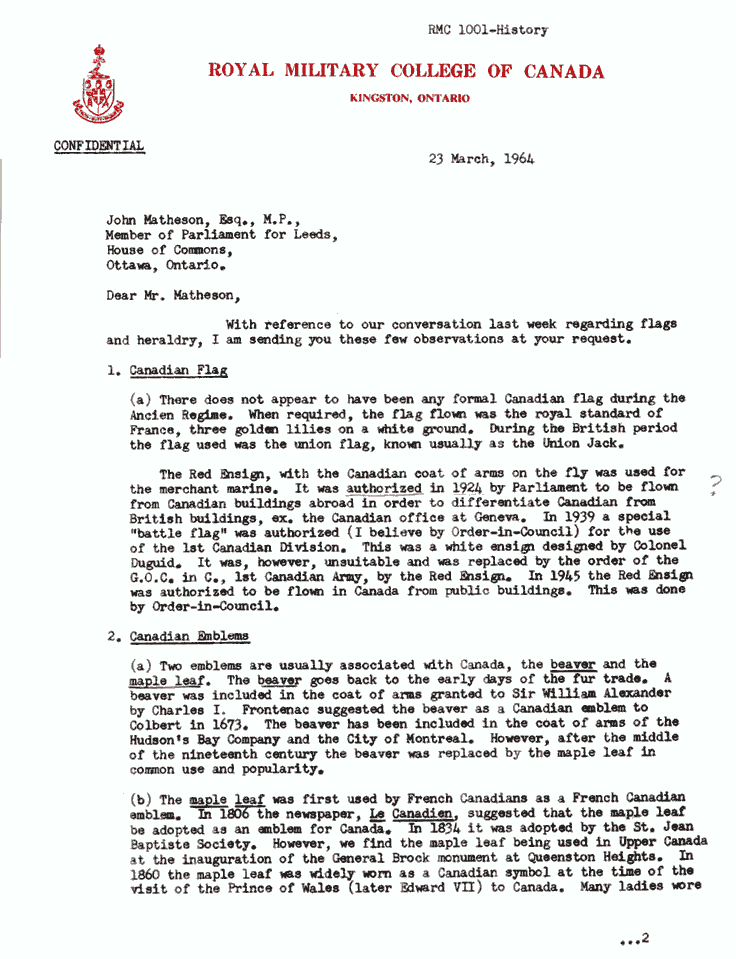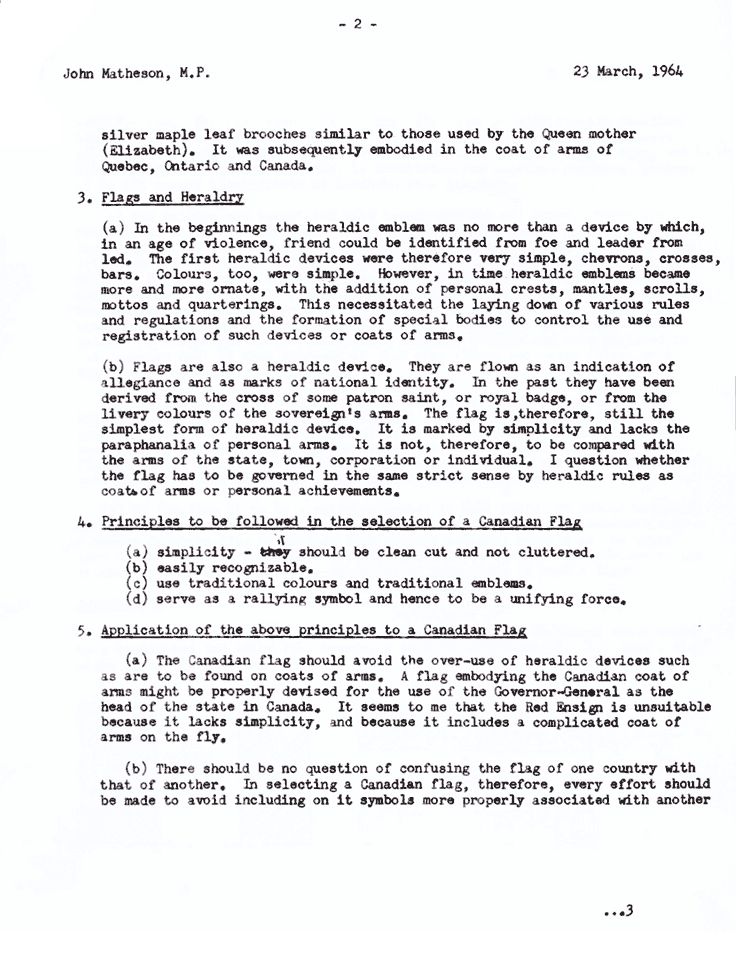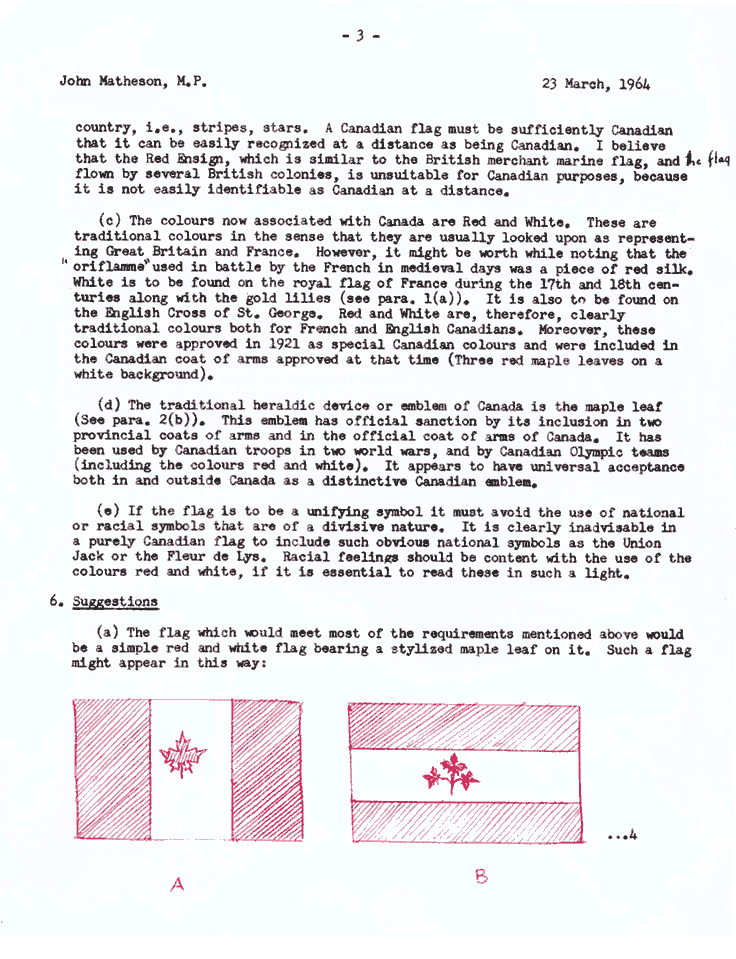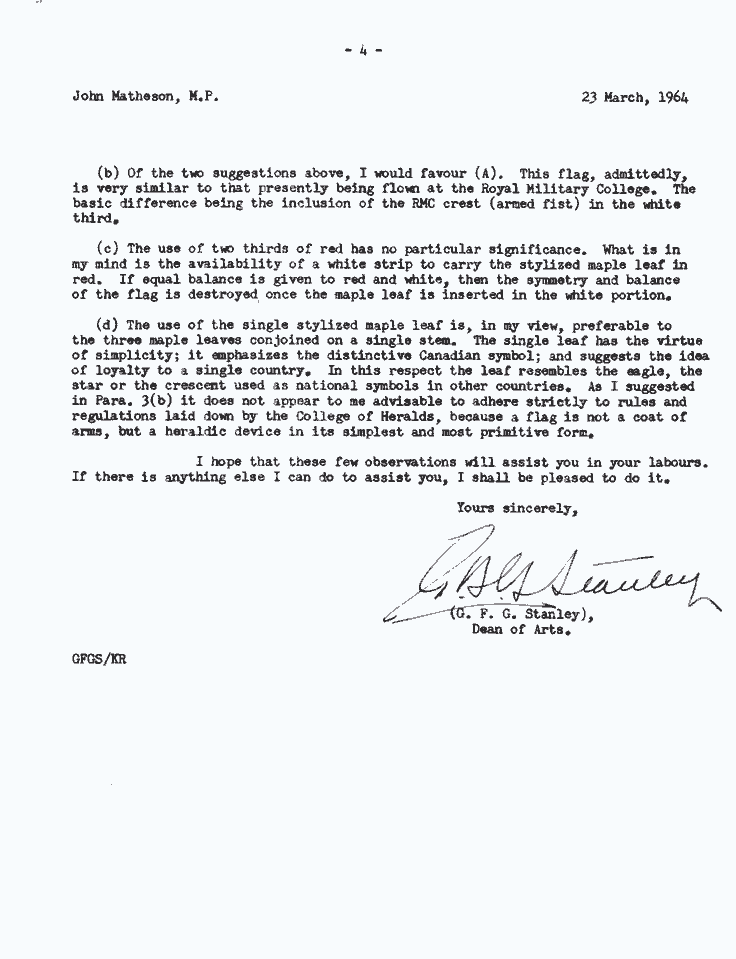



Library and Archives Canada, Alan Beddoe Papers, MG30, D252, vol. 9. Reprinted with permission.
[Transcript of Dr. George F.G. Stanley's Flag Memorandum
to John Matheson, 23 March 1964]
RMC 1001-History
ROYAL MILITARY COLLEGE OF CANADA
KINGSTON, ONTARIO
CONFIDENTIAL
23 March, 1964
John Matheson, Esq., M.P.,
Member of Parliament for Leeds,
House of Commons,
Ottawa, Ontario.
Dear Mr. Matheson,With reference to our conversation last week regarding flags and heraldry, I am sending you these few observations at your request.
Canadian Flag
(a) There does not appear to have been any formal Canadian flag during the Ancien Regime. When required, the flag flown was the royal standard of France, three golden lilies on a white ground. During the British period the flag used was the union flag, known usually as the Union Jack.[b] The Red Ensign, with the Canadian coat of arms on the fly was used for the merchant marine. It was authorized in 1924 by Parliament to be flown from Canadian buildings abroad in order to differentiate Canadian from British buildings, ex. the Canadian office at Geneva. In 1939, a special "battle flag" was authorized (I believe by Order-in-Council) for the use of the 1st Canadian Division. This was a white ensign designed by Colonel [A. Fortescue] Duguid. It was, however, unsuitable and was replaced by the order of the G.O.C. in C., 1st Canadian Army, by the Red Ensign. In 1945 the Red Ensign was authorized to be flown in Canada from public buildings. This was done by Order-in-Council.
Canadian Emblems
(a) Two emblems are usually associated with Canada, the beaver and the maple leaf. The beaver goes back to the early days of the fur trade. A beaver was included in the coat of arms granted to Sir William Alexander by Charles I. Frontenac suggested the beaver as a Canadian emblem to Colbert in 1673. The beaver has been included in the coat of arms of the Hudson's Bay Company and the City of Montreal. However, after the middle of the nineteenth century the beaver was replaced by the maple leaf in common use and popularity.
(b) The maple leaf was first used by French Canadians as a French Canadian emblem. In 1805 the newspaper, Le Canadien, suggested that the maple leaf be adopted as an emblem for Canada. In 1834 it was adopted by the St. Jean Baptiste Society. However, we find the maple leaf being used in Upper Canada at the inauguration of the General Brock monument at Queenston Heights. In 1860 the maple leaf was widely worn as a Canadian symbol at the time of the visit of the Prince of Wales (later Edward VII) to Canada. Many ladies wore silver maple leaf brooches similar to those used by the Queen mother (Elizabeth). It was subsequently embodied in the coat of arms of Quebec, Ontario and Canada.
Flags and Heraldry
(a) In the beginnings the heraldic emblem was no more than a device by which, in an age of violence, friend could be identified fromfoe and leader from led. The first heraldic devices were therefore very simple, chevrons, crosses, bars. Colours, too, were simple. However, in time the heraldic emblems became more and more ornate, with the addition of personal crests, mantles, scrolls, mottos and quarterings. This necessitated the laying down of various rules and regulations and the formation of special bodies to control the use and registration of such devices of coats of arms.
(b) Flags are also a heraldic device. They are flown as an indication of allegiance and as marks of national identity. In the past they have been derived from the cross of some patron saint, or royal badge, or from the livery colours of the sovereign's arms. The flag is, therefore, still the simplest form of heraldic device. It is marked by simplicity and lacks the paraphanalia of personal arms. It is not, therefore, to be compared with the arms of the state, town, or corporation or individual. I question whether the flag has to be governed in the same strict sense by heraldic rules as coats of arms or personal achievements.
Principles to be followed in the selection of a Canadian Flag
(a) simplicity - it should be clean cut and not cluttered.
(b) easily recognizable.
(c) use traditional colours and traditional emblems.
(d) serve as a rallying symbol and hence to be a unifying force.
Application of the above principles to a Canadian Flag
(a) The Canadian flag should avoid the over-use of heraldic devices such as are to be found on coats of arms. A flag embodying the Canadian coat of arms might be properly devised for the use of the Governor-General as the head of the state in Canada. It seems to me that the Red Ensign is unsuitable because it lacks simplicity, and because it includes a complicated coat of arms on the fly.
(b) There should be no question of confusing the flag of one country with that of another. In selecting a Canadian flag, therefore, every effort should be made to avoid including on it symbols more properly associated with another country, i.e., stripes, stars. A Canadian flag must be sufficiently Canadian that it can be easily recognized at a distance as being Canadian. I believe that the Red Ensign, which is similar to the British merchant marine flag, and the flag flown by several British colonies, is unsuitable for Canadian purposes, because it is not easily identifiable as Canadian at a distance.
(c) The colours now associated with Canada are Red and White. These are traditional colours in the sense that they are usually looked upon as representing Great Britain and France. However, it might be worth while noting that the "oriflamme" used in battle by the French in medieval days was a piece of red silk. White is to be found on the royal flag of France during the 17th and 18th centuries along with the gold lilies (see para. 1(a)). It is also to be found on the English Cross of St. George. Red and White are, therefore, clearly traditional colours for French and English Canadians. Moreover, these colours were approved in 1921 as special Canadian colours and were included in the Canadian coat of arms approved at that time (Three red maple leaves on a white background).
(d) The traditional heraldic device or emblem of Canada is the maple leaf (see para. 2(b)). This emblem has official sanction by its inclusion in two provincial coats of arms and in the official coat of arms of Canada. It has been used by Canadian troops in two world wars, and by Canadian Olympic teams (including the colours red and white). It appears to have universal acceptance both in and outside Canada as a distinctive Canadian emblem.
(e) If the flag is to be a unifying symbol it must avoid the use of national or racial symbols that are of a divisive nature. It is clearly inadvisable in a purely Canadian flag to include such obvious national symbols as the Union Jack or the Fleur de Lys. Racial feelings should be content with the use of the colours red and white, if it is essential to read these in such a light.
Suggestions
(a) The flag which would meet most of the requirements mentioned above would be a simple red and white flag bearing a stylized maple leaf on it. Such a flag might appear in this way:
A B
(b) Of the two suggestions above, I would favour (A). This flag, admittedly, is very similar to that presently being flown at the Royal Military college. The basic difference being the inclusion of the RMC crest (armed fist) in the white third.
(c) The use of two thirds of red has no particular significance. What is in my mind is the availability of a white strip to carry the stylized maple leaf in red. If equal balance is given to red and white, then the symmetry and balance of the flag is destroyed once the maple leaf is inserted in the white portion.
(d) The use of the single stylized maple leaf is, in my view, preferable to the three maple leaves conjoined on a single stem. The single leaf has the virtue of simplicity; it emphasizes the distinctive Canadian symbol; and suggests the idea of loyalty to a single country. In this respect the leaf resembles the eagle, the star or the crescent used as national symbols in other countries. As I suggested in Para. 3(b) it does not appear to me advisable to adhere strictly to rules and regulations laid down by the College of Heralds, because a flag is not a coat of arms, but a heraldic device in the simplest and most primitive form.
I hope that these few observations will assist you in our labours. If there is anything else I can do to assist you, I shall be pleased to do it.
Yours sincerely,
[signature]
(G. F. G. Stanley),
Dean of Arts
GFGS/KR